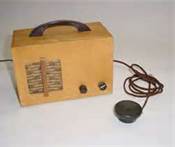04 Feb Part 2 of the Evolution of the Hearing Aid
 In Part 1 of the Evolution of the Hearing Aid, we looked at the first attempts at aiding hearing with acoustic amplifiers such as ear trumpets and conversation cones.
In Part 1 of the Evolution of the Hearing Aid, we looked at the first attempts at aiding hearing with acoustic amplifiers such as ear trumpets and conversation cones.
The first electric hearing aids hit the market after Alexander Graham Bell’s telephone was designed in 1876. Once the telephone was invented, so was the technology that was able to control the loudness and frequency of sounds. This technology was used in the creation of the first electric hearing aid, called the Akouphone which used a carbon transmitter, allowing the aid to be portable. The carbon transmitter was able to amplify a sound by taking a soft sound and using electric current to make it a stronger (louder signal). At the time, these were revolutionary devices, however they were bulky and had poor sound quality.
Next on the scene were vacuum tube hearing aids (picture on right). The first patented vacuum tube hearing aid was designed by a naval engineer in 1920; it was called the Vactuphone and weighed seven pounds, the lightest hearing aid on the market. Eventually, other manufacturers were able to shrink the vacuum tubes, causing hearing aids to decrease in size and attract more users ny the 1930s. These devices were portable, but were tabletop devices rather than in-the-ear models.
Due to military and engineering advances that resulted from World War II, the idea of miniaturization started in the hearing aid industry.


